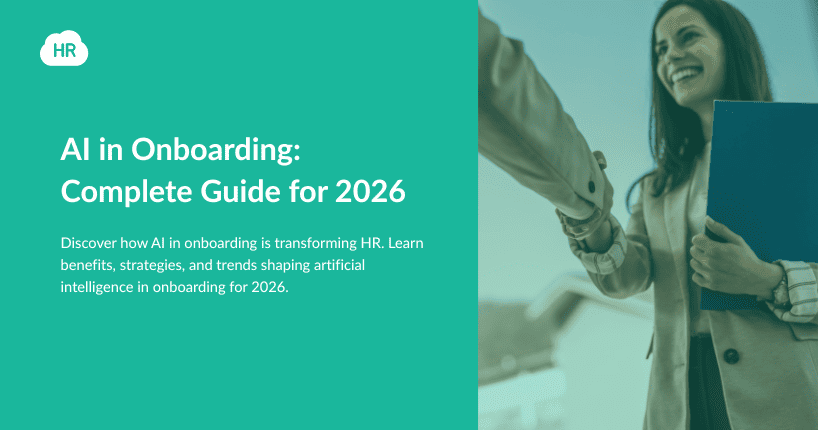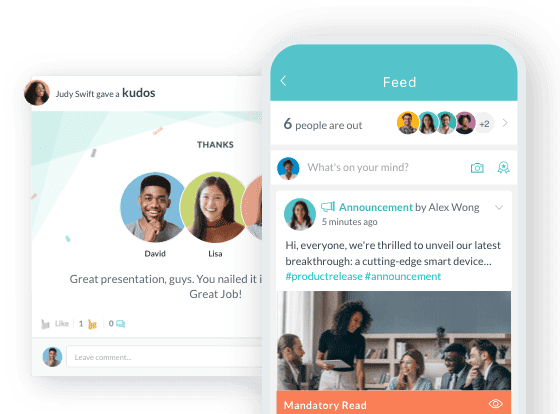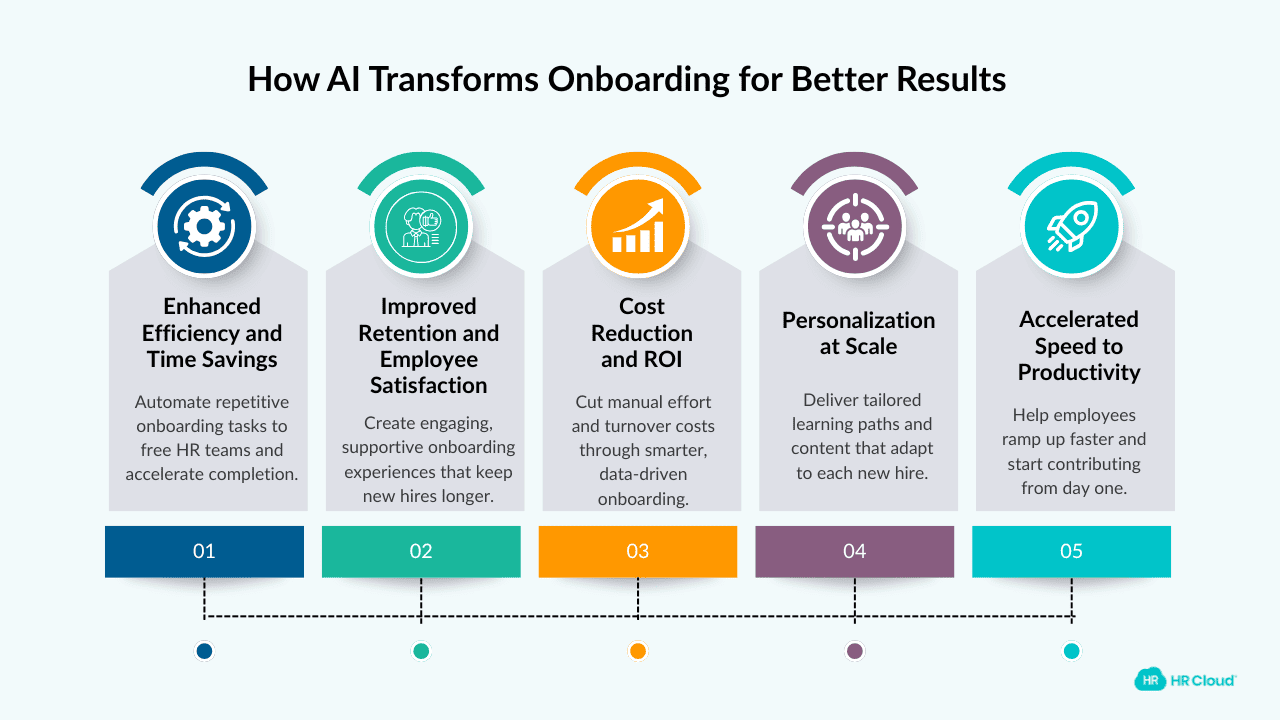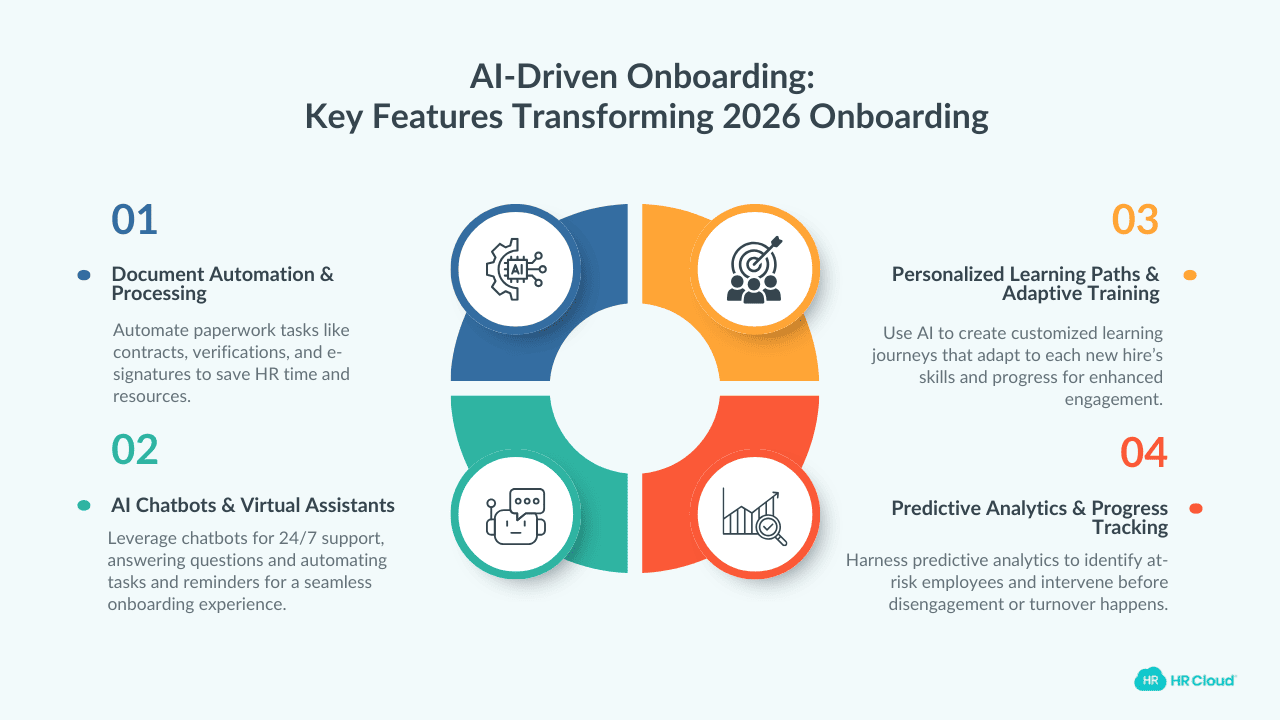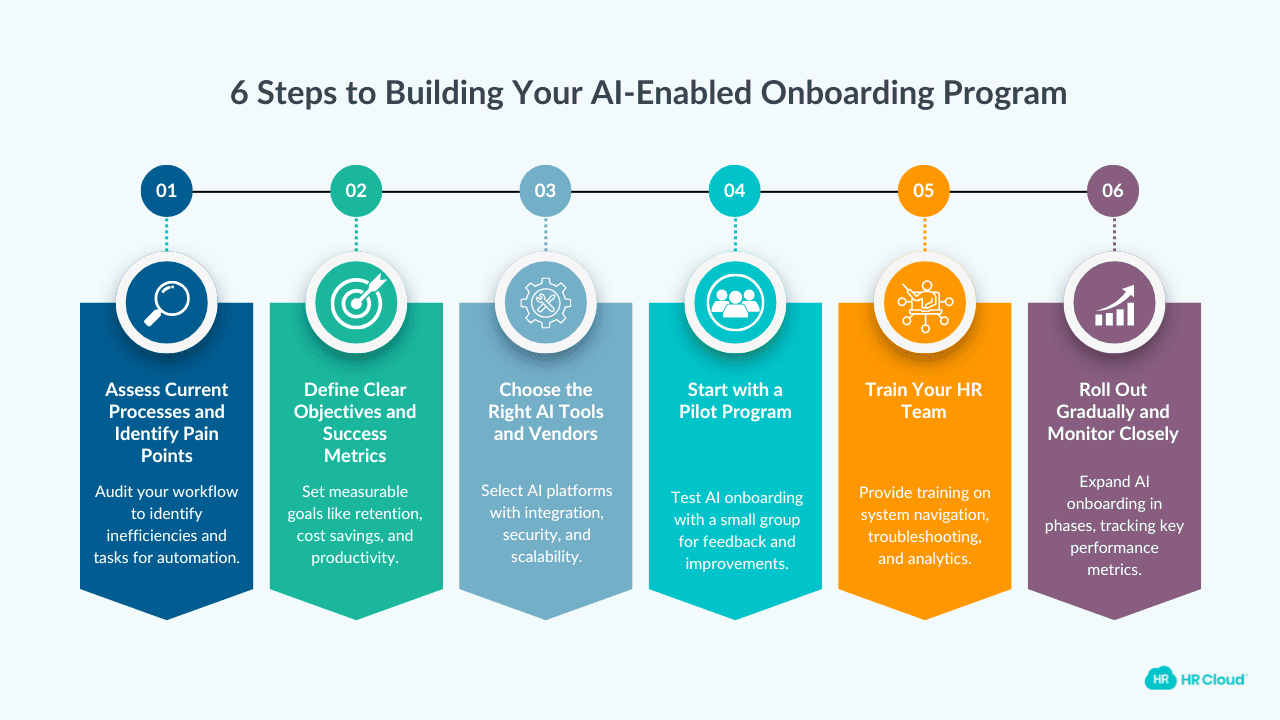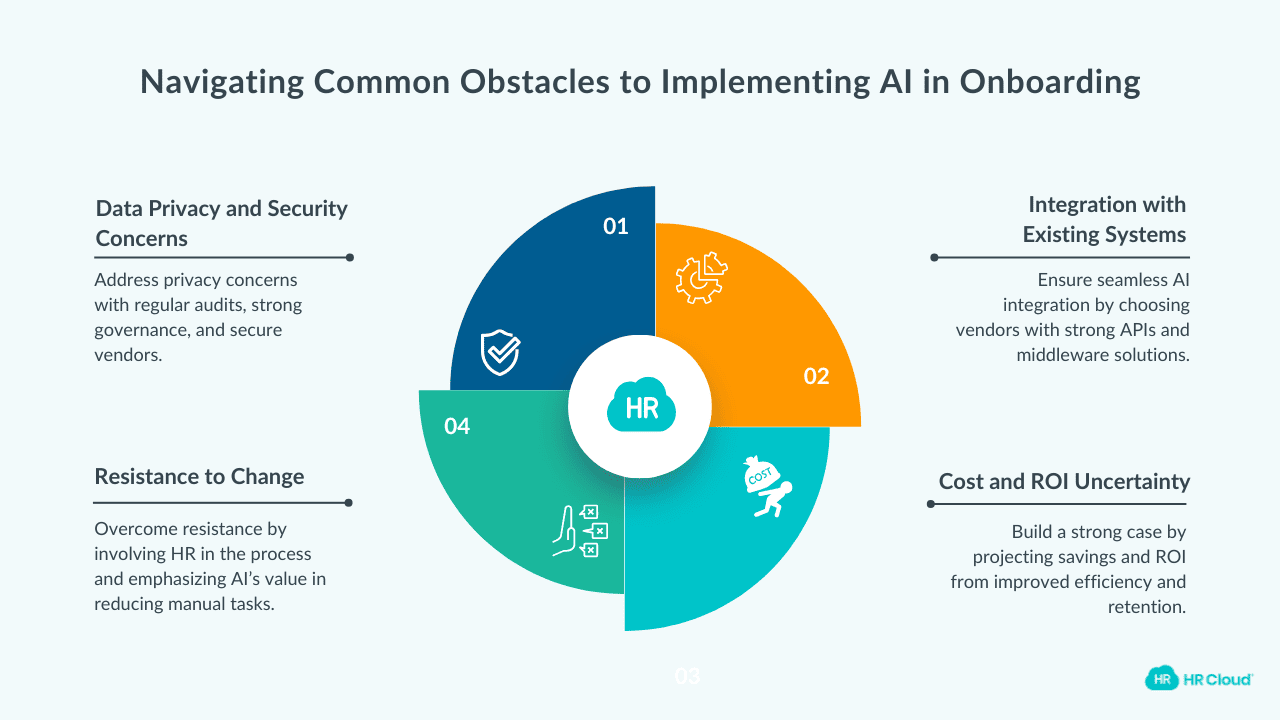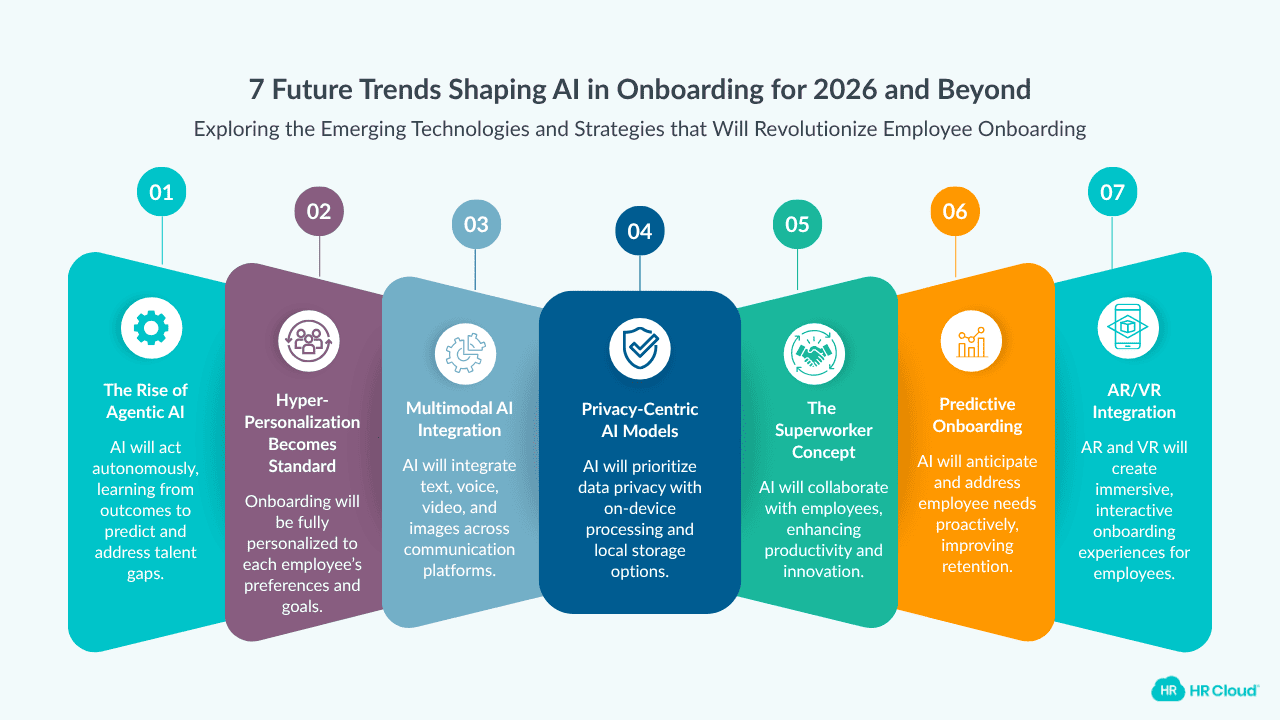- The State of AI in HR and Onboarding
- Understanding AI in Onboarding
- Key Benefits of AI in Onboarding
- Top AI Features Transforming Onboarding in 2026
- 6 Steps to Building Your Own AI in Onboarding Program
- Navigating Common Obstacles to Implementing AI in Onboarding Program
- Measuring Success: Key Metrics for AI Onboarding
- 7 Future Trends to Expect in 2026 and Beyond
- The Future of Onboarding is Here

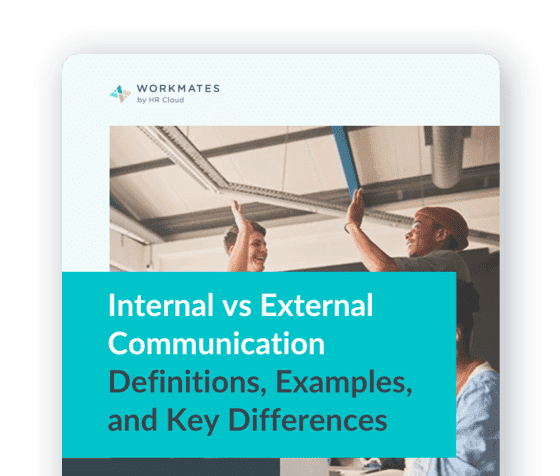
 Cut onboarding time
by 60%—here's the
Ultimate Checklist
that helped do it.
Cut onboarding time
by 60%—here's the
Ultimate Checklist
that helped do it.
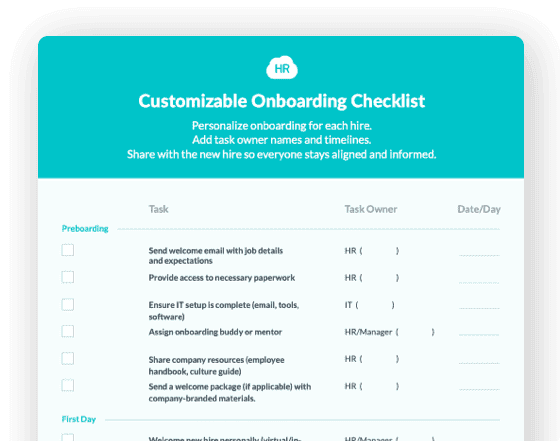
You’ve probably been hearing this multiple times a day — AI is transforming HR. But here’s the real problem: no one tells you what that actually looks like when you’re trying to get a new hire ready for day one.
You’re exhausted from the AI hype. You’ve seen flashy AI demos. Demos that promise magic, but still need you to use checklists and do manual approvals. Maybe this thought has crossed your mind: Everyone else seems to be automating, are we falling behind?
Let me tell you this: that quiet worry that your HR team might be losing its edge is real and valid. Because as per Gartner survey, 61% of organizations were in the latter stages of GenAI implementation in their organization in January 2025.
If you haven’t yet started on your AI transformation journey, don’t panic. You can start with using AI in your existing onboarding processes, one task at a time. In this guide, we’ll cut through the hype and show how to ease your team into using AI in onboarding to turn the typical onboarding chaos into something structured, smart, and definitely more human.
This comprehensive guide explores the complete landscape of AI in onboarding for administrators and HR practitioners, covering the current state of the market, tangible benefits, implementation strategies, challenges to anticipate, and future trends that will shape the industry through 2026 and beyond.
Let’s begin. But first some statistics to put things in perspective, in case you are still wondering if this is worth the effort!
The State of AI in HR and Onboarding
The use of AI in the HR market is experiencing explosive growth. Valued at $6.99 billion in 2025, the artificial intelligence in HR market is projected to reach $14.08 billion by 2029, growing at a compound annual growth rate (CAGR) of 19.1%. This rapid expansion is driven by increasing automation needs, the rise of remote/hybrid work models, and comprehensive digital transformation initiatives across industries.
Within this broader market, AI-powered digital onboarding represents a particularly dynamic segment. The digital onboarding market was valued at $1.62 billion in 2024 and is expected to surge to $8.33 billion by 2033, reflecting a CAGR of 20.8%. The healthcare sector, along with banking, financial services, insurance (BFSI), and IT & telecom, is driving the fastest growth in this space.
Current Adoption Metrics and Trends
The shift toward AI in onboarding is accelerating at an unprecedented pace. Adopting AI in onboarding makes perfect sense considering that companies implementing AI onboarding see an impressive 82% improvement in new hire retention rates.
In fact, by the end of 2025, according to Gartner, 50% of large enterprises will have adopted Agentic AI in at least one core HR function. Additionally, 92% of companies plan to increase their AI investments over the next three years, and 45% of HR professionals currently use AI in some capacity within their operations.
The critical point to note here is that the move towards agentic AI indicates moving from basic automation to intelligent, self-learning systems that can make autonomous decisions.
Organizations are no longer asking whether to implement AI, but rather how quickly they can scale its use to remain competitive.
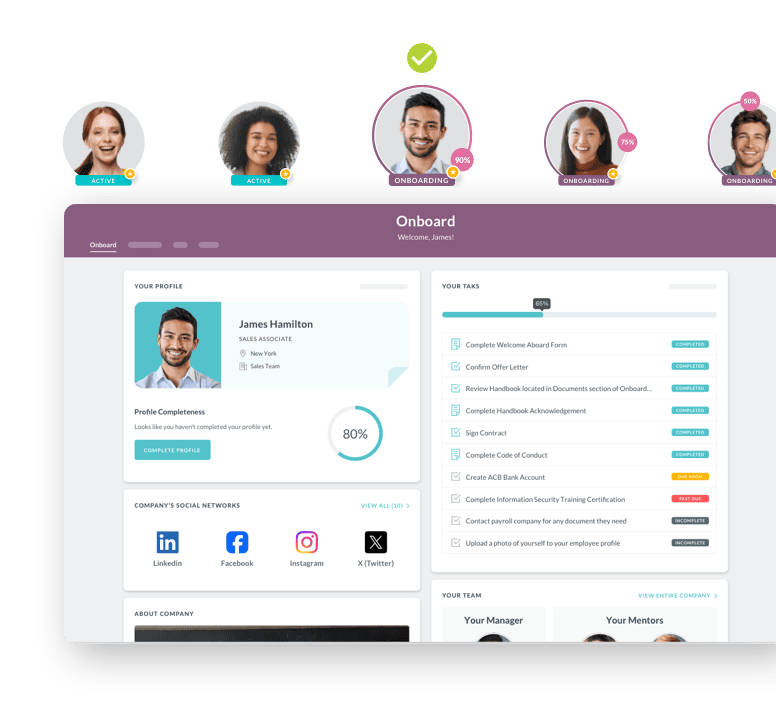
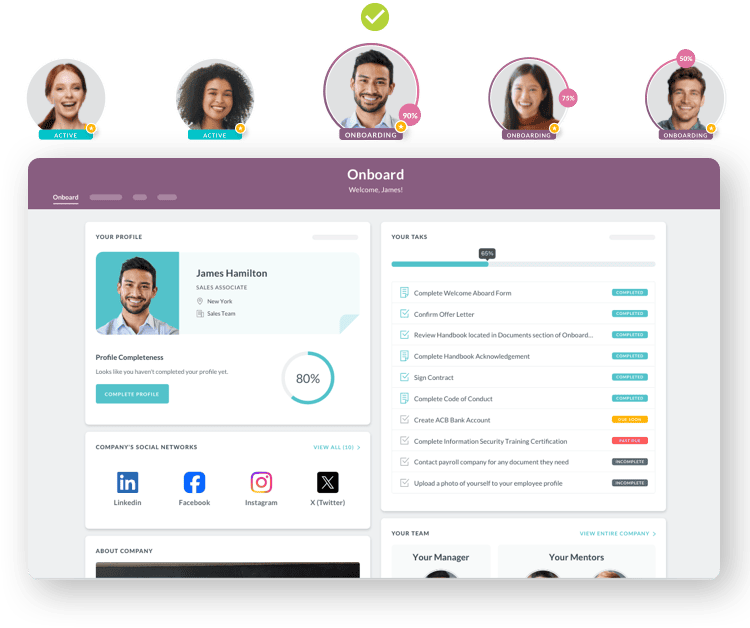
Understanding AI in Onboarding
Let’s begin with the most fundamental of all questions: What is the role of AI in onboarding?
What is AI-Powered Onboarding?
AI-powered onboarding leverages artificial intelligence to automate administrative tasks needed for onboarding new hires, personalize their experiences, and enhance the entire new hire journey from pre-boarding through complete integration into the company culture.
Core capabilities of an AI-powered onboard solution includes:
-
Automated document processing and verification
-
Personalized learning path creation
-
24/7 virtual assistance through chatbots
-
Real-time progress tracking and analytics
-
Predictive insights for retention and engagement
Evolution From Automation to Agentic AI
The evolution of AI in onboarding has occurred in three distinct stages.
- The first stage, from 2020 to 2023, featured automation through rules-based systems that handled repetitive tasks.
- The second stage, spanning 2023 to 2025, introduced Generative AI, enabling content creation, personalized communications, and adaptive learning.
- The third stage, which began in 2025, will continue through 2026 and 2027, marks the rise of Agentic AI – systems capable of autonomous decision-making with minimal human intervention.
This evolution from AI models and algorithms and chats to AI agents is profound. Because Agentic AI can act independently, making decisions based on data patterns and learning from outcomes. Gartner predicts that by 2026, 40% of enterprise applications will leverage task-specific AI agents, up dramatically from less than 5% in 2025.
This would mark a fundamental shift in how organizations approach onboarding technology.
The question is, are you one of the 40% or 60%?
Key Benefits of AI in Onboarding
Using AI in onboarding has multiple benefits, from resource optimization to cost savings. Let’s discuss a few most important ones in detail.
Enhanced Efficiency and Time Savings
AI delivers remarkable productivity gains in onboarding processes. Organizations implementing AI solutions report 53% faster onboarding process completion, a 75% reduction in administrative workload for HR teams, a 50% reduction in administrative tasks overall, and a 73% reduction in errors in employee data collection.
Improved Retention and Employee Satisfaction
Perhaps the most compelling benefit of AI onboarding is its impact on retention. Organizations with robust AI onboarding programs see an 82% improvement in new hire retention rates within the first year. Employees feel more supported, engaged, and integrated from day one.
The numbers on satisfaction are equally impressive. Companies using AI onboarding report average employee satisfaction ratings of 4.5 out of 5.
Cost Reduction and ROI
The financial impact of AI onboarding is substantial. Companies implementing these systems save over $18,000 annually due to improved retention and operational efficiency. Additionally, AI reduces recruitment costs by 30%, and lower turnover significantly decreases replacement costs.
Most organizations see their AI onboarding system paying for itself within the first year of implementation, making it a sound financial investment.
Personalization at Scale
One of AI's most powerful capabilities is delivering personalization at scale.
AI analyzes each employee's role, experience level, skills, and learning style to create customized learning paths. The system adjusts content delivery in real-time based on progress and feedback, ensuring that each new hire receives the right information at the right time.
What once took HR weeks to customize manually can now be accomplished in minutes through AI, without sacrificing quality or relevance.
Accelerated Speed to Productivity
AI-powered onboarding significantly accelerates how quickly new hires become productive team members. Organizations report that new employees reach full functionality 40% faster and become productive team members 35% sooner compared to traditional onboarding methods.
This reduced time-to-productivity translates directly into business value, as new hires contribute meaningfully to organizational goals much earlier in their tenure.
Top AI Features Transforming Onboarding in 2026
You cannot really up and decide one fine day that you're going to start using AI in all your HR processes. You must go step-by-step. Starting with baby steps towards an AI powered onboarding.
Here are the easiest tasks/workflows to automate using AI.
Document Automation and Processing
AI excels at automating document-related tasks that traditionally consumed significant HR time. Modern systems automatically:
-
generate employment contracts, NDAs, and offer letters
-
collect and verify digital documents
-
integrate e-signature workflows for paperless processing
-
synchronize data automatically with HR systems.
A DocuSign case study showed a 75% reduction in HR administrative workload through document automation alone.
AI Chatbots and Virtual Assistants
Bank of America's virtual assistant Erica handles 58 million interactions per month. Since its launch in 2018, it has handled 3 billion client interactions and assisted 50 million users.
AI chatbots can provide 24/7 support to new hires, instantly answering questions about policies, benefits, and procedures. They can also help automate task assignments and reminders to all stakeholders, and not just the new hires.
Personalized Learning Paths and Adaptive Training
AI creates progressive learning sequences tailored to individual needs by analyzing employee profiles, skills, experience, and role requirements. These systems adjust content difficulty based on performance and feedback, delivering bite-sized, interactive modules for better retention.
Predictive Analytics and Progress Tracking
Modern AI systems provide real-time dashboards showing onboarding completion rates and identify at-risk employees before they disengage or leave. These predictive capabilities enable proactive intervention, allowing HR teams to address issues before they escalate.
AI can forecast which new hires may struggle or leave based on engagement patterns and behavioral signals. You can then use these insights to roll out timely interventions that can dramatically improve the outcomes.
6 Steps to Building Your Own AI in Onboarding Program
Now, let's help you build your own AI enabled onboarding program.
Step 1: Assess Current Processes and Identify Pain Points
Begin by auditing your existing onboarding workflow.
Map every touchpoint, identify bottlenecks and inefficiencies, and gather feedback from recent hires and HR staff. Survey new employees and HR teams to understand the most frustrating or time-consuming aspects of your current process. Finally, document repetitive tasks that could be automated and pinpoint areas where personalization is lacking.
This assessment creates a baseline against which you can prioritize which processes need to be addressed first. It will also be useful when you need to measure improvement later on.
Step 2: Define Clear Objectives and Success Metrics
Establish specific, measurable goals for your AI onboarding initiative. Common objectives can be:
-
Reducing time-to-productivity by 35-40%
-
Improving 90-day retention by at least 15%
-
Achieving 4.5 out of 5 satisfaction scores
-
Decreasing administrative time by 50%
-
Lowering onboarding costs by 30%
The objectives that you choose must be aligned with the broader organizational goals. This will help secure buy-in from the leadership by demonstrating the expected ROI and business impact.
Step 3: Choose the Right AI Tools and Vendors
Now it's time to select the right platforms or vendors. When you are exploring the options you have, keep in mind these critical factors:
-
Healthcare industry-specific features and compliance capabilities
-
Integration with your existing HRIS and ATS systems
-
Proven track record with healthcare clients
-
Scalability to grow with your organization
-
Data security and HIPAA compliance
-
User-friendly interfaces for both HR and new hires
Request demos, check references, and conduct pilot tests with multiple vendors before making a final decision.
For healthcare organizations, compliance features and industry-specific workflows are particularly critical.
Note: right place to insert HR Cloud offering.
 — Kaylee Collins, HR Analyst.
— Kaylee Collins, HR Analyst.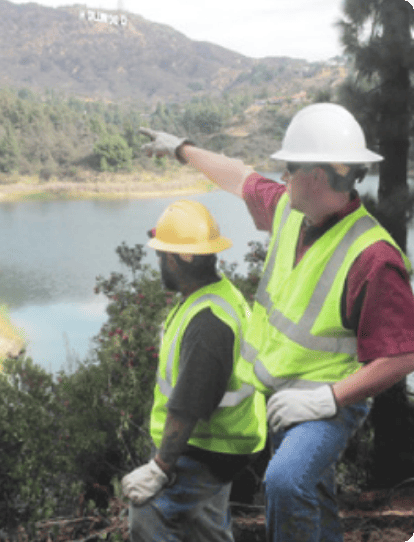
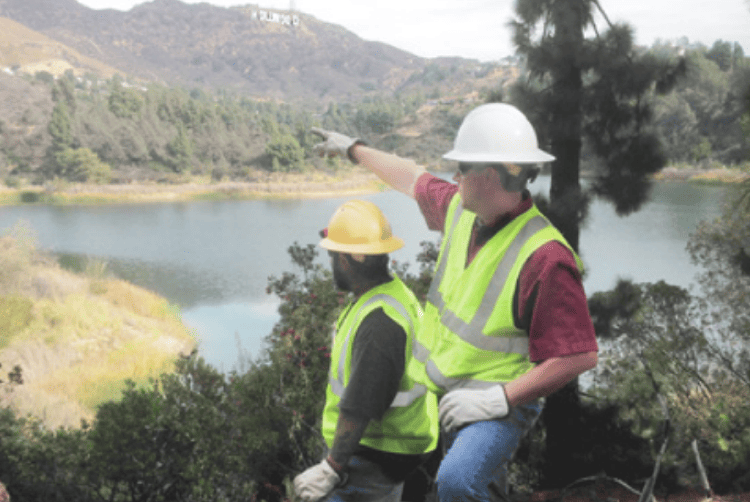
Step 4: Start with a Pilot Program
Rather than rolling out AI onboarding organization-wide immediately, begin with a limited pilot. Here is how:
1. Select one department or location for initial implementation, typically choosing a manageable cohort of 20-50 new hires.
2. Run the pilot for 3-6 months, collecting detailed feedback from all stakeholders.
3. Monitor key metrics closely during this period and be prepared to make iterative improvements based on real-world usage.
A successful pilot builds internal champions and provides concrete data to support broader rollout.
Step 5: Train Your HR Team
Your HR team must be comfortable and proficient with the new AI tools. Provide comprehensive training covering:
-
System navigation
-
How to customize content and workflows
-
Troubleshooting common issues
-
Interpreting analytics and dashboards
-
When to intervene in automated processes
Assign system administrators and super-users who can serve as internal resources. Remember, change management is as crucial as technical implementation for success. Invite them to voice their concerns, address them proactively and emphasize how AI will enhance, not replace, the human elements of HR work.
Step 6: Roll Out Gradually and Monitor Closely
After a successful pilot, expand implementation in phases. Roll out to additional departments or locations incrementally, allowing time to address issues and optimize processes between expansions.
Keep Monitoring key performance indicators continuously, including time-to-productivity, retention rates, employee satisfaction scores, and cost savings. Use these metrics to demonstrate value and secure continued investment.
And don’t forget to celebrate wins publicly to build momentum and organizational support for the initiative.
Navigating Common Obstacles to Implementing AI in Onboarding Program
Rolling out any new initiative has its own challenges. Here are some of the challenges that you should be on a lookout for. We are also proposing a few solutions. You can consider.
Data Privacy and Security Concerns
Organizations, especially in regulation intensive industries such as Healthcare and insurance must be vigilant about data privacy and sensitivity of employee information.
Some steps that can be taken include:
-
Conducting regular security audits
-
Establishing clear data governance policies
-
Implementing data encryption and access controls
-
Choosing vendors with robust security certifications
Ensure that AI systems process sensitive information in compliance with all applicable regulations. And, employee data should be used only for intended purposes with appropriate consent.
Integration with Existing Systems
Legacy HR systems may not easily integrate with new AI tools, creating data silos and workflow inefficiencies. Here is how you can address Address this:
-
Prioritizing vendors offering robust API integrations with popular HRIS platforms
-
Using middleware solutions when necessary to bridge systems
-
Planning for a phased migration if replacing legacy systems entirely
Work closely with IT teams during implementation to ensure seamless data flow and avoid duplicative data entry.
Resistance to Change
HR staff and new hires may resist AI-driven processes due to fears of job displacement or assuming others’ preference for human interaction. You can overcome this resistance through:
-
Transparent communication about how AI will augment, not replace, HR professionals
-
Maintaining human touchpoints throughout the onboarding journey
-
Involving HR staff in the selection and implementation process
-
Highlighting early wins and positive outcomes
Emphasize that AI handles routine administrative burdens so that HR can focus on building relationships and providing strategic value.
Cost and ROI Uncertainty
Initial costs of implementing AI onboarding can be significant and ROI may not be immediately apparent. Build a strong business case by:
-
Benchmarking against industry data showing typical ROI timelines
-
Calculating current costs of poor onboarding including turnover expenses
-
Projecting savings from reduced administrative time and improved retention
-
Starting with scalable solutions that allow you to expand as value is demonstrated
We are still in the early days of AI adoption in HR but having clear metrics from the outset helps track progress toward this goal.
Measuring Success: Key Metrics for AI Onboarding
To demonstrate the value of your AI onboarding investment, track these critical metrics consistently.
-
Time-to-Productivity measures how quickly new hires reach full performance capacity.
-
Retention Rates are perhaps the most important measure of onboarding success. Track 90-day, 6-month, and 1-year retention rates and compare them to historical baselines. Calculate turnover costs saved by multiplying prevented departures by the average cost of replacing an employee.
-
Employee Satisfaction Scores provide direct feedback on the onboarding experience. Target an average rating of 4.5 out of 5, using end-of-onboarding surveys and pulse checks. Track Net Promoter Score (eNPS) to gauge whether new hires would recommend your organization to others. High satisfaction scores correlate strongly with retention and performance.
-
Cost Savings should be tracked across multiple dimensions. Direct savings of $18,000+ annually per organization from improved retention and efficiency is established. So track it. Additional savings can include a reduction in administrative tasks, lower recruitment costs due to better retention, and reduced turnover-related expenses. Calculate total cost of ownership against these savings to demonstrate clear ROI.
-
Engagement and Performance Metrics tie onboarding success to business outcomes. Research shows that organizations with engaged workforces see 8-10% revenue growth, outperform peers by 147% in earnings per share, and achieve 12% higher customer satisfaction scores.
7 Future Trends to Expect in 2026 and Beyond
As mentioned earlier, we are still in the early phases of AI adoption in HR. In fact, AI technology itself is undergoing shifts on a daily basis. It is important for you to keep an eye on the future trends so that you are in opposition to take advantage of the latest developments.
The Rise of Agentic AI
Agentic AI represents the next frontier In adoption of AI in HR. Agent AI is an artificial intelligence system that acts autonomously, learns from outcomes, and continuously improves processes without human oversight.
These systems will proactively identify talent gaps and initiate recruitment before needs arise. According to Gartner, by 2026, 40% of enterprise applications will use task-specific AI agents, fundamentally transforming how organizations approach not just onboarding, but all HR functions.
Hyper-Personalization Becomes Standard
By 2025, 70% of organizations will use AI for personalized employee experiences, making hyper-personalization the expected standard rather than a differentiator. Every aspect of onboarding will be tailored to individual preferences, learning styles, and career goals, with dynamic content that evolves based on real-time engagement.
The one-size-fits-all onboarding approach will become obsolete.
Multimodal AI Integration
Future AI platforms will seamlessly process text, voice, video, and images within single integrated systems. Communication will flow effortlessly across channels like Slack, Teams, and email, with natural conversational interfaces that feel increasingly human.
This multimodal capability will make AI assistants more versatile and accessible to users with different preferences and abilities.
Privacy-Centric AI Models
Following Apple's privacy-first approach, future AI systems will increasingly feature on-device processing to protect sensitive data, local data storage options for compliance, and enhanced focus on data sovereignty.
Healthcare organizations, with their stringent privacy requirements, will particularly benefit from these developments as AI becomes more privacy-preserving by design.
The Superworker Concept
HR thought leader Josh Bersin envisions a future where employees leverage AI as co-workers rather than mere tools. AI will augment human creativity and strategic thinking, dramatically enhancing productivity, performance, and innovation.
The focus will shift from AI replacing humans to AI-human collaboration that achieves outcomes neither could accomplish alone.
Predictive Onboarding
Next-generation AI will anticipate employee needs before they arise, enabling proactive interventions based on behavioral patterns. Systems will provide predictive career pathing from day one and identify potential issues early, allowing resolution before they impact retention.
This shift from reactive to predictive support will fundamentally change the onboarding experience, and potentially HR workflows.
AR/VR Integration
Augmented and virtual reality will create immersive onboarding experiences including virtual office tours for remote employees, hands-on training simulations, team-building activities in virtual spaces, and interactive policy and procedure walkthroughs.
For healthcare organizations, this could include virtual clinical simulations and facility orientations that prepare new hires more effectively than traditional methods.
The Future of Onboarding is Here
AI has transformed onboarding from a manual, paperwork-heavy process into an intelligent, automated experience that delivers measurable results.
For administrators and HR practitioners, the path forward requires strategic action. Start by assessing your current onboarding process and identifying specific pain points that AI can address. Launch a pilot program in one department or location to test and refine your approach before scaling.
Remember to balance technology with human intervention. AI should enhance efficiency while preserving the human connections that remain essential to successful onboarding.
Finally, measure rigorously from day one to demonstrate ROI and guide continuous improvement. Because what gets measured gets done.
The organizations that will thrive in 2026 and beyond are those that embrace AI responsibly, using it to enhance human capabilities.
The technology is here. The data proves its value. The question is no longer if you should implement AI onboarding, but how quickly you can do so to remain competitive in an increasingly talent-driven market.
 Discover how our HR solutions streamline onboarding, boost employee engagement, and simplify HR management
Discover how our HR solutions streamline onboarding, boost employee engagement, and simplify HR management
FAQs
What is AI in onboarding and how is it different from traditional onboarding?
AI in onboarding uses algorithms, chatbots, and automation to streamline the onboarding process. Traditional onboarding is typically manual, checklist-heavy, and slow. Use of artificial intelligence in onboarding enables personalised journeys for new hires rather than one-size-fits-all, without increasing HR’s workload.
Why should HR leaders care about artificial intelligence in onboarding right now?
Because messy onboarding costs time, morale, and talent. With the help of AI in onboarding process you reduce admin overload, speed up time-to-productivity, and improve retention. It’s about as much about remaining competitivene as it is about efficiency.
Can small and mid-size HR teams use AI in onboarding?
Yes. Lean HR teams that are working overtime can definitely benefit from using AI in onboarding. Artificial intelligence in onboarding tools work with smaller headcounts to automate repetitive tasks and free people to do the more strategic work.
Does AI in onboarding mean less human connection in the onboarding experience?
Not at all. The best onboarding setups using artificial intelligence free up HR teams to focus on strategising, recruitment, building relationships, promoting organizational culture, and work on retaining the talent they have hired. The AI handles repetitive work so you can invest time in meaningful interactions.
What are the first steps to implement AI in onboarding for my organisation?
Start by mapping your current onboarding pain-points (like missing paperwork or slow ramp). Then evaluate solutions focused on artificial intelligence in onboarding that integrate with your HRIS and support new hires. Roll out with a pilot, measure impact, iterate, then scale.
How do I measure success when using AI in onboarding?
To measure success of AI in onboarding, track metrics like time-to-productivity, new hire retention, first-90-day engagement, number of repetitive questions handled by support team or bots, and HR time saved. These metrics help you demonstrate and quantify how effective your artificial intelligence in onboarding investment truly is.

Keep Reading
Credential Tracking in Healthcare: How to Automate License Renewals and Stay Audit-Ready
A nurse shows up ready for her shift but her license expired yesterday. You scramble for
Onboarding 500 Nurses a Year: Lessons from High-Volume Hospital HR Teams
Hiring 5 nurses can be done off-the-cuff. But hiring 500 is a logistics operation by
AI for Frontline HR: Moving Beyond Sentiment Analysis to Build Tomorrow's Workforce Management Engine
TL;DR: While most organizations limit artificial intelligence in human resources to basic
Like What You Hear?
We'd love to chat with you more about how HR Cloud® can support your business's HR needs. Book Your Free Demo

Build a Culture of Recognition. Boost Engagement. Guaranteed.
Workmates empowers employees to stay informed, connected, and appreciated—whether they’re on the front line, in the office, or remote. Recognition drives 12x higher engagement.Trusted by industry leaders in every sector




Cut Onboarding Costs by 60%.
Take the confusion and follow-ups out of onboarding with automated workflows, digital forms, and structured portals—so new hires ramp faster 3X quicker.Trusted by industry leaders in every sector




